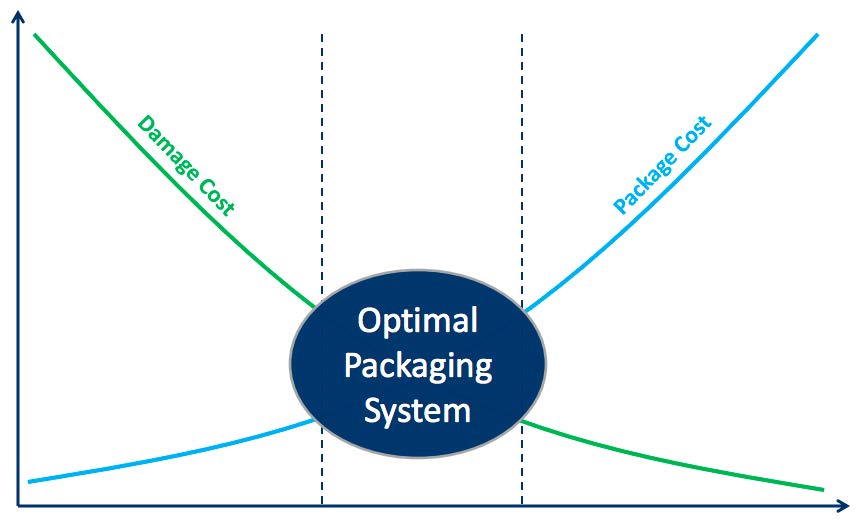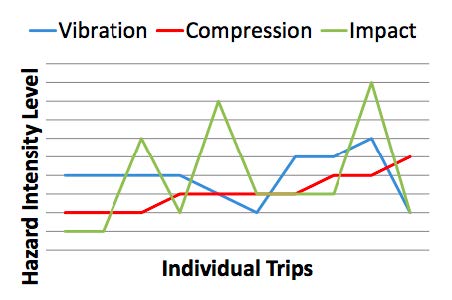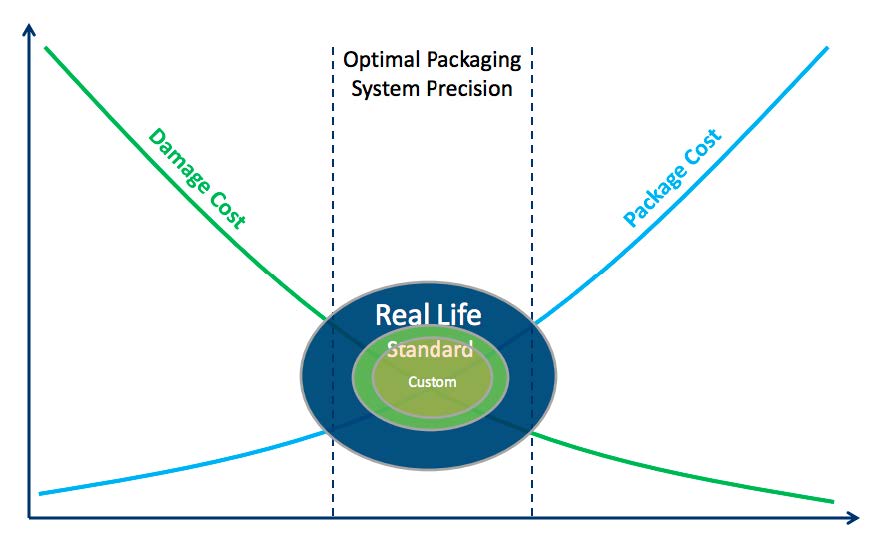The concept of “packaging” is simple: it’s a material that can be used to wrap, seal or pad a product to protect it from damage. Packaging is used both as a marketing strategy, to boost sales, and as an insurance policy to ensure product quality is maintained from the time the product is shipped to the moment a customer receives the product. There are many risks and potential events along the supply chain that a package must withstand, including vibration, compression, mechanical handling, manual handling and atmospheric conditions. With that in mind, it’s important to find the optimal balance in packaging that will withstand many hazards but won’t break the bank.
Just-Right Packaging
Packaging decisions are typically based on three factors: the ability to protect the product throughout the supply chain, the environmental impact of the packaging materials and/or processes, and the cost to produce the packaging. The key drivers are most often protection and cost.
If a product is under-protected, the company potentially saves money on packaging costs but will lose money if the product is damaged before arriving to the consumer. The converse is overprotection; if a product is packaged with more materials than necessary to minimize damage risks, then the environmental impact may increase, costs can be higher and the bottom line will still be negatively affected.

The ideal solution lies with Just-Right Packaging, a method that balances protection and costs. The Just-Right Packaging concept is simple in theory, but its inherent variability presents major challenges to packaging professionals seeking optimal solutions.
Challenges of Variability
Variability exists everywhere, and all products are subject to different conditions that can affect the integrity of the final product. Environmental variability presents the biggest challenge; modes of travel, routes taken, road quality and weather patterns are different for every supply chain, thus a product’s protection needs can become extremely unpredictable.

Another consideration within the supply chain is the variance of transported products. Product robustness variability is important because even if the hazards along the supply route are the same every time, the damage can increase and decrease based on the failure threshold of the products being shipped. For example, the fragility level of a breakfast cereal shipment will be much higher than that of an auto parts shipment, but both may be subject to the same shipping and handling procedures.
Understanding the correlation between product behavior and shipping hazards can affect whether the product is consumer acceptable or generates consumer complaints. This understanding can be achieved through effective package testing. Real-life testing involves shipping actual product with actual equipment without controlling hazard variability; standard transit testing utilizes controlled laboratory equipment and subjects a package to ASTM, ISTA, ASO, CEN and / or BSI guidelines; and custom transit testing utilizes controlled laboratory equipment, focusing on the correlation between lab results and known field results. The pros and cons to each type of testing will be explored.
Real-Life Testing
The easiest option of the three methods, real-life tests are actual shipments in their natural state; just put the product on transport and see what happens. There’s no need to time compress vibration, and this method doesn’t usually require a third-party expert to achieve results, which makes real-life testing the easiest insourced option.
However, there are major disadvantages to this method. It’s time consuming, and more importantly, isn’t as effective because it’s not a true test. Because there is no control over hazard variables, results can be misleading or inconclusive. Although real-life testing is valuable, the lack of control makes this testing method unreliable for validation.
Standard Transit Testing
Standard testing is the most widely used method, because it relies on recognized industry standards (ASTM, ISTA, ASO, CEN and BSI) to validate against controlled inputs. There is no associated development time because these standards already exist, and testing can be performed on smaller samples of products, making it a faster, more cost-effective solution than real-life testing.
The downside of standard transit testing is that the simulation is generalized and requires a third-party with special equipment to test effectively; tests are based on generalized supply chains, safety factors are built in, and the risk of damage is hard to understand. Standard testing is intended to output repeatable results that generate measurable, comparable results.
Although standard transit testing is a more effective option than real-life testing, cost saving opportunities exist when we take a closer look at the cause-effect relationship between hazard and damage conditions.
Custom Transit Testing
The goal of custom transit testing is to manage individual risk by accurately predicting how a product will withstand the hazards in the supply chain. A sound understanding of this analysis will help to maximize the bottom line. A blend between art and science, custom transit testing is the most thorough route to cost savings because it leverages what is known about the product and what others know about supply chain and testing methodologies.
Custom testing also allows for the determination of absolute failure levels under specific conditions. With standard testing, a package either passes or fails, leaving the failure threshold unknown.
The benefit of custom testing is that provides valuable data for packaging professionals, because it determines the optimal intersection between how much protection a product needs and the cost to protect it.
For example, a company can achieve a zero-percent damage rate but in doing so runs the risk of overspending on packaging protection. With custom testing, the company could better identify the failure threshold for the product’s packaging and as a result spend less on packaging while still maintaining a low and predictable damage rate. The company saves money by optimizing the packaging and thus reducing packaging expenses.
Custom testing navigates and explores the spaces where opportunities exist for better ROI, offsetting the cost of the specialized expertise and equipment associated with finding these opportunities.
The PACKSmart Calculator
It’s difficult to imagine cost savings without a deeper look at the individual variables of a company’s packaging operations.
One tool that accounts for these variables when seeking cost-saving opportunities is the PACKSmart Calculator. It uses a company’s current product data to quantify package cost savings, damage reduction cost savings, and possible ROI for custom testing utilization.
The PACKSmart Calculator is a tool that provides packaging professionals the ability to experiment with different packaging scenarios and use the calculations for internal approvals and estimates, ideal for cost-reduction evaluation and sustainable packaging development projects.
The Bottom Line

The Optimal Packaging System is best achieved by finding a balance between real-life, standard transit and custom transit testing.
Real-life testing can be effective in determining the effects of consistent hazards (vibration) but because of the lack of control it does not predict the inconsistent hazards present in the supply chain (human interactions). Standard testing determines the acceptable minimum thresholds for packaging, with controlled testing benchmarks that produce generalized results. Custom testing examines all hazard variables, and pinpoints the minimum and maximum thresholds for packaging with precision data to find the best cost-saving opportunities.
About Mike Kuebler
As technical director for the Smithers Pira (smitherspira.com) Testing Laboratory in Lansing, Michigan, Mike Kuebler guides a team of packaging experts who analyze the true impact that the supply chain has on a package. Whether manufacturers are looking to optimize the cost and design of their current packaging, reduce the use of packaging materials to contribute to sustainability initiatives or analyze and correct package damage issues, Kuebler keeps the focus of all efforts on the concept of “Just Right Packaging.”
Kuebler has over 15 years of experience in the transportation and packaging industries, including six years with Smithers Pira. He has held engineering positions with well-known companies in the packaging and consumer goods industries. Michael is a graduate of the prestigious School of Packaging at Michigan State University with a Bachelor of Science degree in Packaging Engineering.

